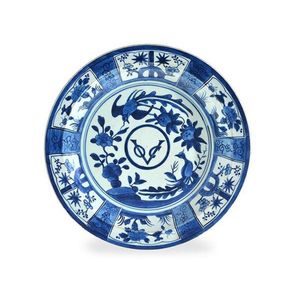Ming Dynasty Blue and White Charger with Cranes
You must be a subscriber, and be logged in to view price and dealer details.
Subscribe Now to view actual auction price for this item
When you subscribe, you have the option of setting the currency in which to display prices to $Au, $US, $NZ or Stg.
- Ming Dynasty - The Ming Dynasty was a ruling dynasty of China from 1368 to 1644. It succeeded the Yuan Dynasty and preceded the Qing Dynasty. The Ming Dynasty was established by Zhu Yuanzhang, a former Buddhist monk who became a rebel leader and eventually overthrew the Mongol Yuan Dynasty. During the Ming Dynasty, China experienced a period of relative stability and prosperity. The government was centralized and bureaucratic, with the emperor at the top of the hierarchy. The Ming Dynasty is known for its cultural achievements, including the development of porcelain, the invention of movable type printing, and the construction of the Great Wall of China.
- Charger - A charger is a type of large plate, typically used as a decorative base for smaller plates or bowls. They are often used in formal settings, such as at a banquet or a special occasion.
The history of chargers can be traced back to medieval times, when they were used as a base for serving dishes in banquet settings. They were typically made of metal, such as silver or pewter, and were highly decorative, often featuring intricate engravings or designs.
During the Renaissance period, chargers began to be made of porcelain, and their designs became more ornate. They were often used in the homes of the wealthy and were considered a symbol of wealth and status.
In the 18th and 19th centuries, chargers were produced in great numbers by European porcelain manufacturers, and they were exported to America and other parts of the world. They were highly sought after by the upper class and were often used as a decorative element in formal table settings.
This item has been included into following indexes:
Visually similar items

A Japanese Arita blue and white porcelain V.O.C. Plate, 17th century, circa 1680, a Museum quality underglaze dish with Voc (Vereenigde Oostindische Compagnic - Dutch East India Company) insignia surrounded by long tail phoenix (ho-ho) birds, persimmons an

Antique Chinese porcelain side plate Naively decorated in underglaze blue with the Canton pattern. Late 19th century. Original condition. Diameter 18.5 cm

Chinese antique blue & white bowl, decorated with 'three Friends' Jingdezhen Kiln - 16th century, 19 cm diameter. Heavily restored

19th century Chinese blue and white rice grain plate, with gold gilding and crane centre pattern. Guangxu (1875-1908) mark and period. Provenance: Illustrated in Allen's Introduction to Later Chinese Porcelain, Fig 29. Diameter 20 cm
